Portage College NURS 152: Abdomen and Gastrointestinal System Report
VerifiedAdded on 2022/08/13
|5
|681
|122
Report
AI Summary
This report, prepared for a NURS 152 Health Assessment assignment, provides a detailed overview of the abdomen and gastrointestinal system. It begins by outlining the structure of the GI tract, including the esophagus, stomach, small and large intestines, and accessory organs like the liver, pancreas, and gallbladder. The report then delves into the function of each component, explaining how food is broken down and absorbed. This includes the role of enzymes, the absorption of nutrients in the small intestine, and the absorption of water in the large intestine. Finally, the report references health assessment questions and physical assessment techniques relevant to the abdomen and gastrointestinal system. The report is complete with references to support the information provided.
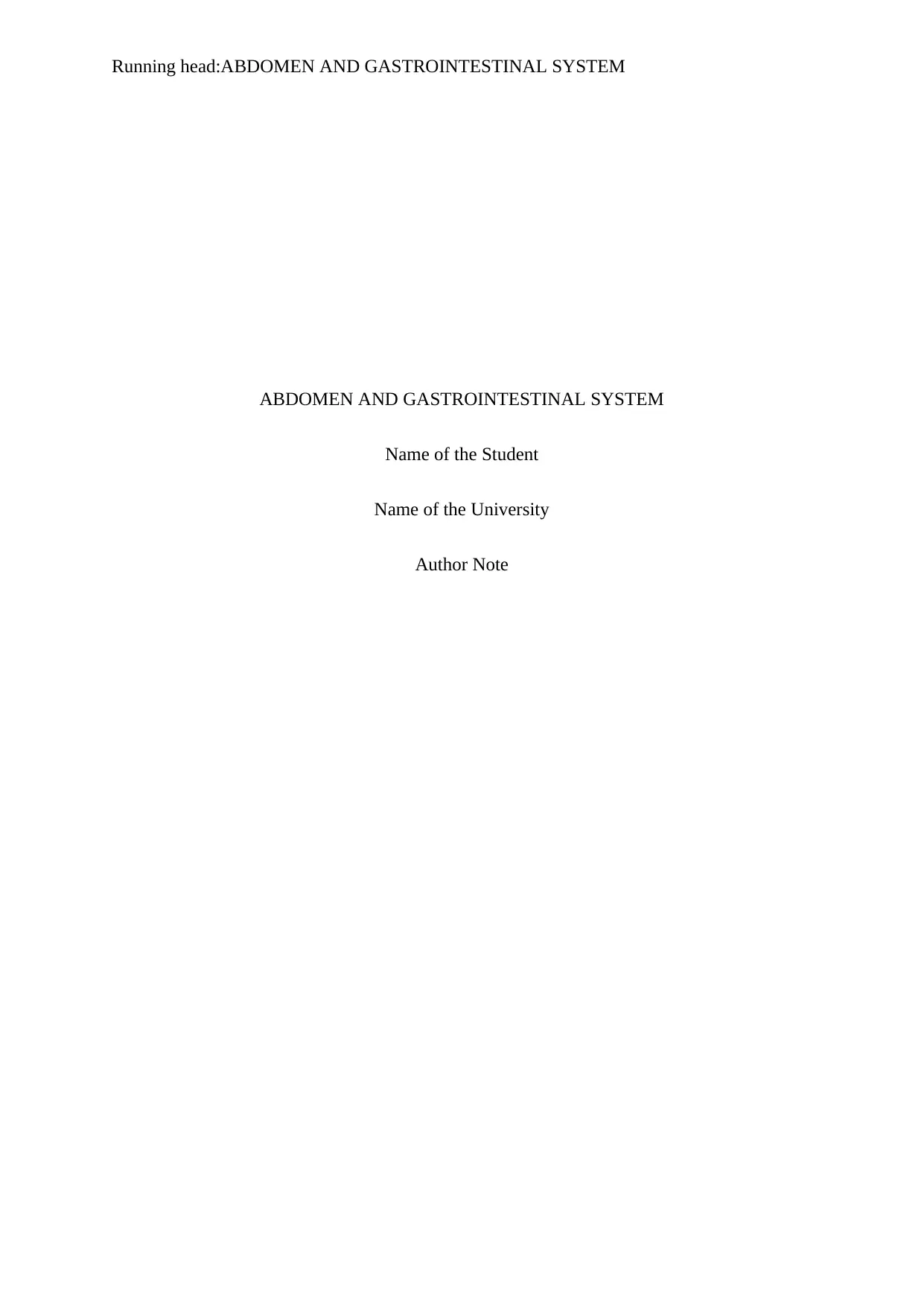
Running head:ABDOMEN AND GASTROINTESTINAL SYSTEM
ABDOMEN AND GASTROINTESTINAL SYSTEM
Name of the Student
Name of the University
Author Note
ABDOMEN AND GASTROINTESTINAL SYSTEM
Name of the Student
Name of the University
Author Note
Paraphrase This Document
Need a fresh take? Get an instant paraphrase of this document with our AI Paraphraser
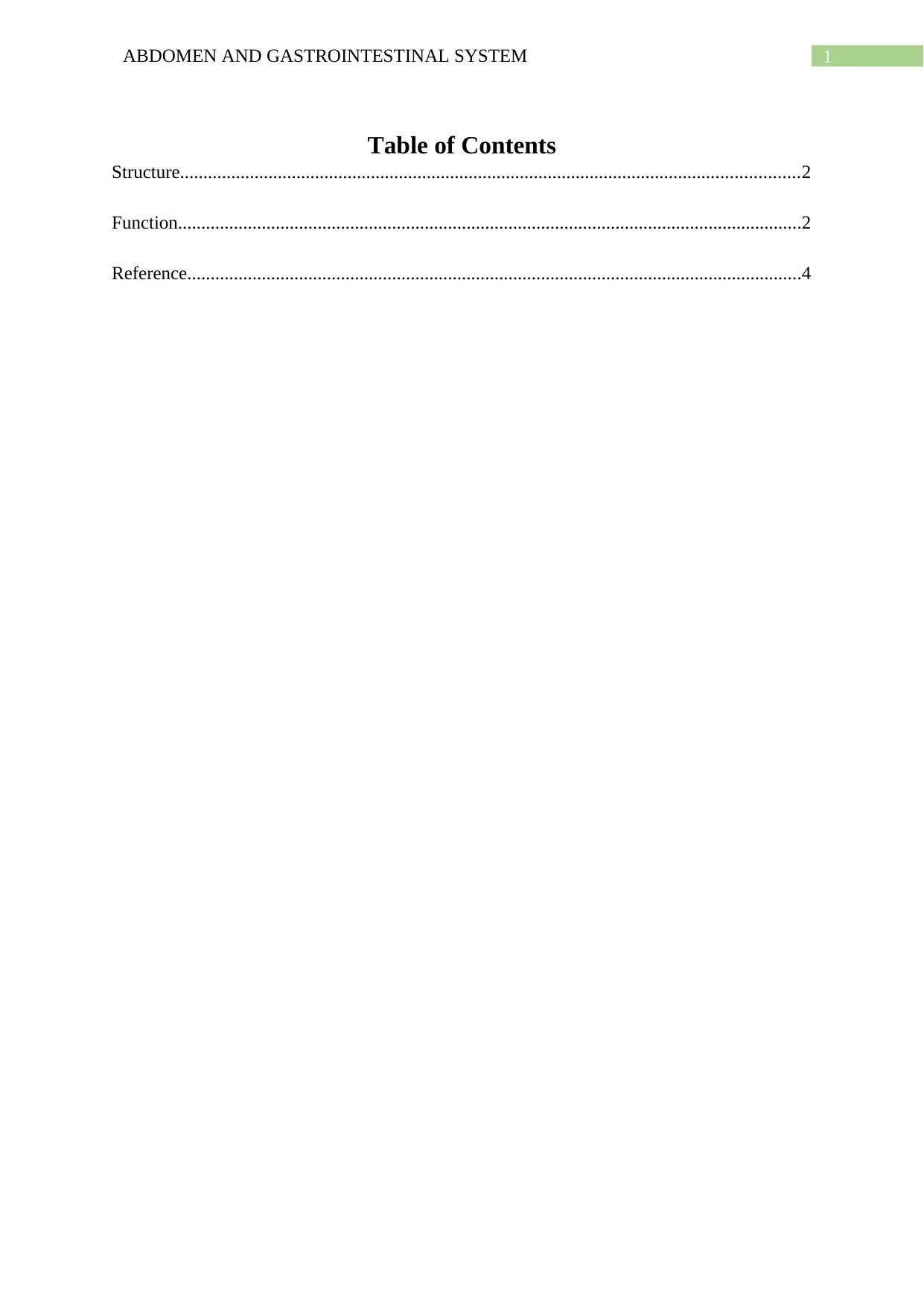
1ABDOMEN AND GASTROINTESTINAL SYSTEM
Table of Contents
Structure.....................................................................................................................................2
Function......................................................................................................................................2
Reference....................................................................................................................................4
Table of Contents
Structure.....................................................................................................................................2
Function......................................................................................................................................2
Reference....................................................................................................................................4
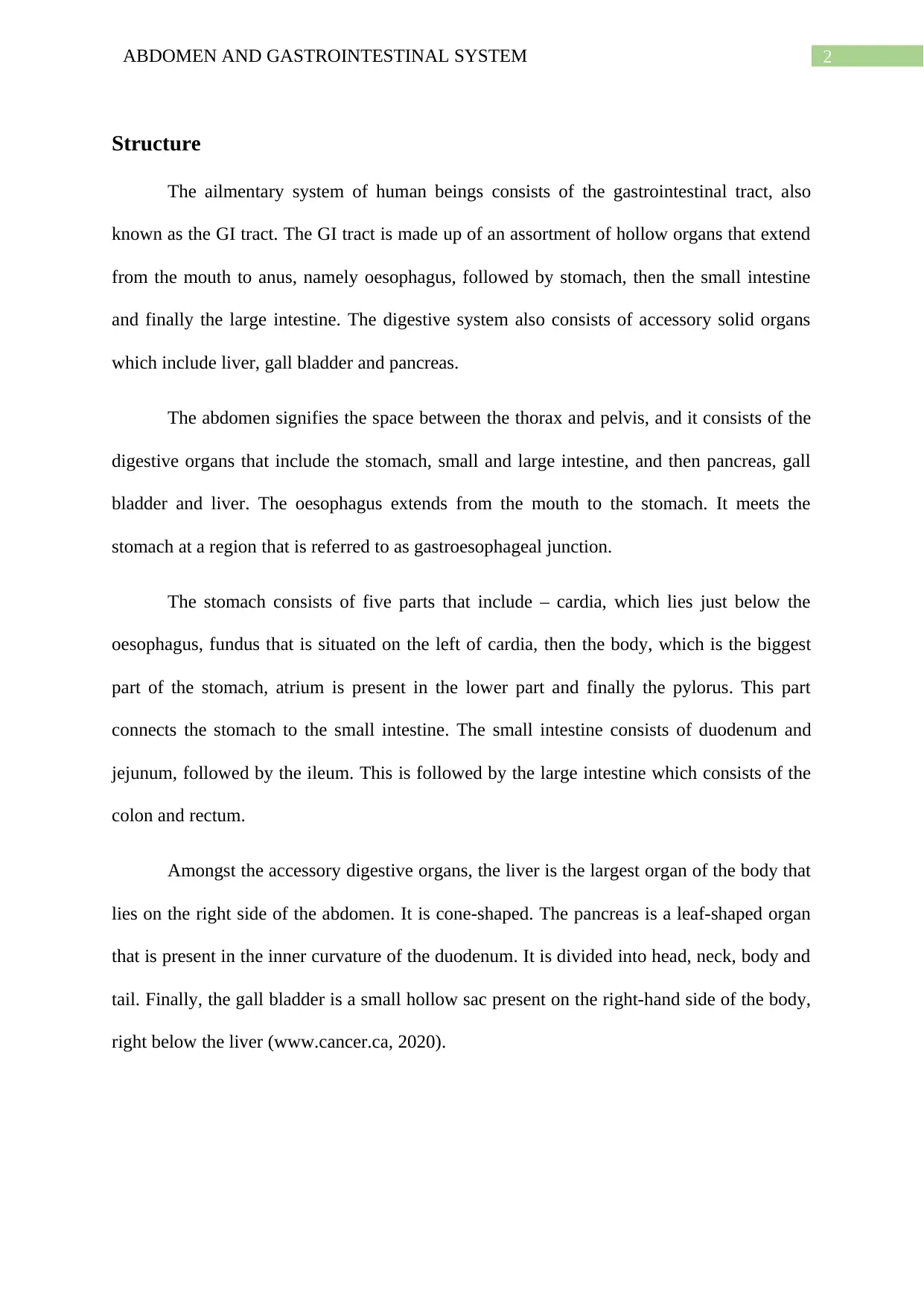
2ABDOMEN AND GASTROINTESTINAL SYSTEM
Structure
The ailmentary system of human beings consists of the gastrointestinal tract, also
known as the GI tract. The GI tract is made up of an assortment of hollow organs that extend
from the mouth to anus, namely oesophagus, followed by stomach, then the small intestine
and finally the large intestine. The digestive system also consists of accessory solid organs
which include liver, gall bladder and pancreas.
The abdomen signifies the space between the thorax and pelvis, and it consists of the
digestive organs that include the stomach, small and large intestine, and then pancreas, gall
bladder and liver. The oesophagus extends from the mouth to the stomach. It meets the
stomach at a region that is referred to as gastroesophageal junction.
The stomach consists of five parts that include – cardia, which lies just below the
oesophagus, fundus that is situated on the left of cardia, then the body, which is the biggest
part of the stomach, atrium is present in the lower part and finally the pylorus. This part
connects the stomach to the small intestine. The small intestine consists of duodenum and
jejunum, followed by the ileum. This is followed by the large intestine which consists of the
colon and rectum.
Amongst the accessory digestive organs, the liver is the largest organ of the body that
lies on the right side of the abdomen. It is cone-shaped. The pancreas is a leaf-shaped organ
that is present in the inner curvature of the duodenum. It is divided into head, neck, body and
tail. Finally, the gall bladder is a small hollow sac present on the right-hand side of the body,
right below the liver (www.cancer.ca, 2020).
Structure
The ailmentary system of human beings consists of the gastrointestinal tract, also
known as the GI tract. The GI tract is made up of an assortment of hollow organs that extend
from the mouth to anus, namely oesophagus, followed by stomach, then the small intestine
and finally the large intestine. The digestive system also consists of accessory solid organs
which include liver, gall bladder and pancreas.
The abdomen signifies the space between the thorax and pelvis, and it consists of the
digestive organs that include the stomach, small and large intestine, and then pancreas, gall
bladder and liver. The oesophagus extends from the mouth to the stomach. It meets the
stomach at a region that is referred to as gastroesophageal junction.
The stomach consists of five parts that include – cardia, which lies just below the
oesophagus, fundus that is situated on the left of cardia, then the body, which is the biggest
part of the stomach, atrium is present in the lower part and finally the pylorus. This part
connects the stomach to the small intestine. The small intestine consists of duodenum and
jejunum, followed by the ileum. This is followed by the large intestine which consists of the
colon and rectum.
Amongst the accessory digestive organs, the liver is the largest organ of the body that
lies on the right side of the abdomen. It is cone-shaped. The pancreas is a leaf-shaped organ
that is present in the inner curvature of the duodenum. It is divided into head, neck, body and
tail. Finally, the gall bladder is a small hollow sac present on the right-hand side of the body,
right below the liver (www.cancer.ca, 2020).
⊘ This is a preview!⊘
Do you want full access?
Subscribe today to unlock all pages.

Trusted by 1+ million students worldwide
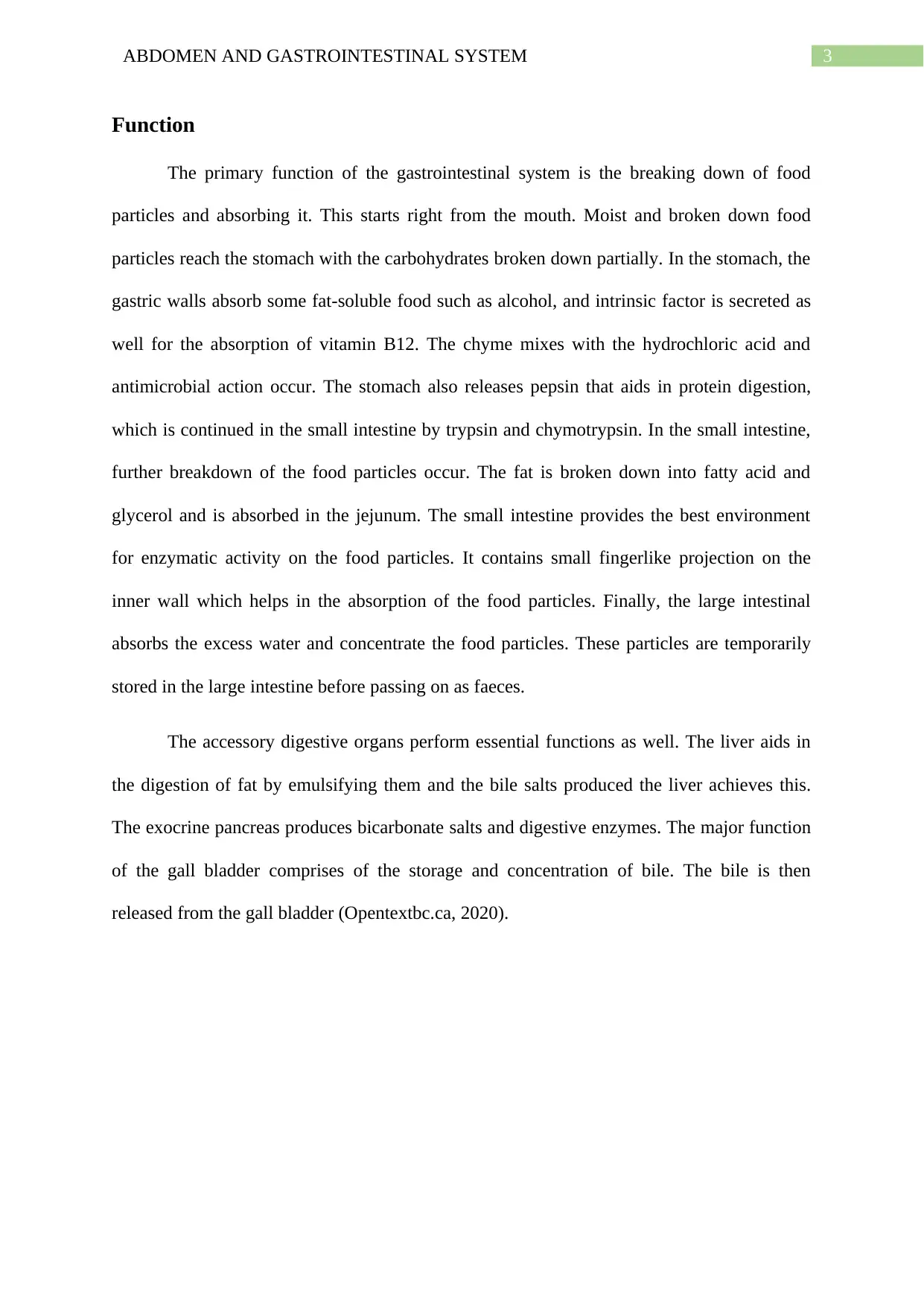
3ABDOMEN AND GASTROINTESTINAL SYSTEM
Function
The primary function of the gastrointestinal system is the breaking down of food
particles and absorbing it. This starts right from the mouth. Moist and broken down food
particles reach the stomach with the carbohydrates broken down partially. In the stomach, the
gastric walls absorb some fat-soluble food such as alcohol, and intrinsic factor is secreted as
well for the absorption of vitamin B12. The chyme mixes with the hydrochloric acid and
antimicrobial action occur. The stomach also releases pepsin that aids in protein digestion,
which is continued in the small intestine by trypsin and chymotrypsin. In the small intestine,
further breakdown of the food particles occur. The fat is broken down into fatty acid and
glycerol and is absorbed in the jejunum. The small intestine provides the best environment
for enzymatic activity on the food particles. It contains small fingerlike projection on the
inner wall which helps in the absorption of the food particles. Finally, the large intestinal
absorbs the excess water and concentrate the food particles. These particles are temporarily
stored in the large intestine before passing on as faeces.
The accessory digestive organs perform essential functions as well. The liver aids in
the digestion of fat by emulsifying them and the bile salts produced the liver achieves this.
The exocrine pancreas produces bicarbonate salts and digestive enzymes. The major function
of the gall bladder comprises of the storage and concentration of bile. The bile is then
released from the gall bladder (Opentextbc.ca, 2020).
Function
The primary function of the gastrointestinal system is the breaking down of food
particles and absorbing it. This starts right from the mouth. Moist and broken down food
particles reach the stomach with the carbohydrates broken down partially. In the stomach, the
gastric walls absorb some fat-soluble food such as alcohol, and intrinsic factor is secreted as
well for the absorption of vitamin B12. The chyme mixes with the hydrochloric acid and
antimicrobial action occur. The stomach also releases pepsin that aids in protein digestion,
which is continued in the small intestine by trypsin and chymotrypsin. In the small intestine,
further breakdown of the food particles occur. The fat is broken down into fatty acid and
glycerol and is absorbed in the jejunum. The small intestine provides the best environment
for enzymatic activity on the food particles. It contains small fingerlike projection on the
inner wall which helps in the absorption of the food particles. Finally, the large intestinal
absorbs the excess water and concentrate the food particles. These particles are temporarily
stored in the large intestine before passing on as faeces.
The accessory digestive organs perform essential functions as well. The liver aids in
the digestion of fat by emulsifying them and the bile salts produced the liver achieves this.
The exocrine pancreas produces bicarbonate salts and digestive enzymes. The major function
of the gall bladder comprises of the storage and concentration of bile. The bile is then
released from the gall bladder (Opentextbc.ca, 2020).
Paraphrase This Document
Need a fresh take? Get an instant paraphrase of this document with our AI Paraphraser
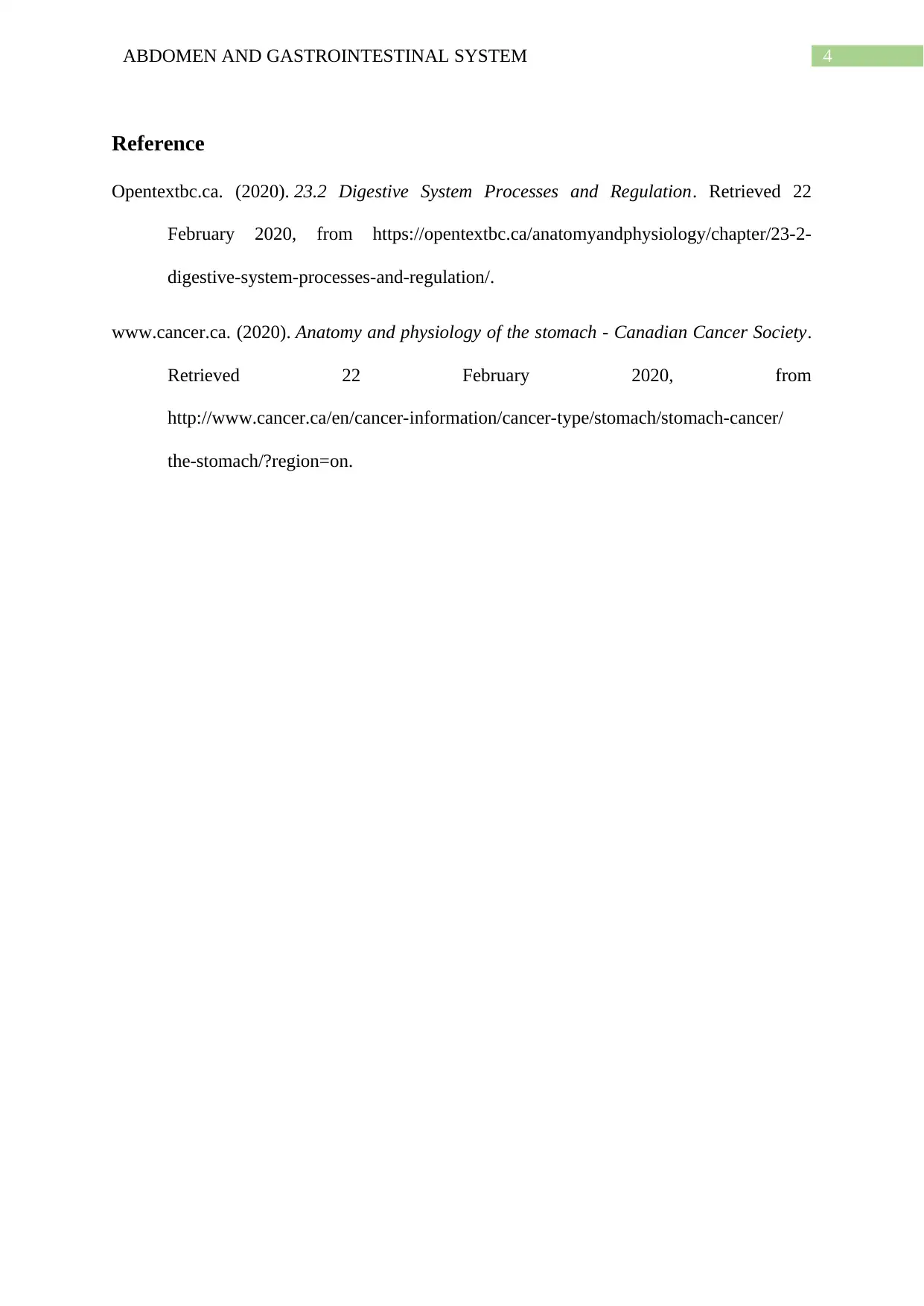
4ABDOMEN AND GASTROINTESTINAL SYSTEM
Reference
Opentextbc.ca. (2020). 23.2 Digestive System Processes and Regulation. Retrieved 22
February 2020, from https://opentextbc.ca/anatomyandphysiology/chapter/23-2-
digestive-system-processes-and-regulation/.
www.cancer.ca. (2020). Anatomy and physiology of the stomach - Canadian Cancer Society.
Retrieved 22 February 2020, from
http://www.cancer.ca/en/cancer-information/cancer-type/stomach/stomach-cancer/
the-stomach/?region=on.
Reference
Opentextbc.ca. (2020). 23.2 Digestive System Processes and Regulation. Retrieved 22
February 2020, from https://opentextbc.ca/anatomyandphysiology/chapter/23-2-
digestive-system-processes-and-regulation/.
www.cancer.ca. (2020). Anatomy and physiology of the stomach - Canadian Cancer Society.
Retrieved 22 February 2020, from
http://www.cancer.ca/en/cancer-information/cancer-type/stomach/stomach-cancer/
the-stomach/?region=on.
1 out of 5
Related Documents
Your All-in-One AI-Powered Toolkit for Academic Success.
+13062052269
info@desklib.com
Available 24*7 on WhatsApp / Email
![[object Object]](/_next/static/media/star-bottom.7253800d.svg)
Unlock your academic potential
Copyright © 2020–2025 A2Z Services. All Rights Reserved. Developed and managed by ZUCOL.




